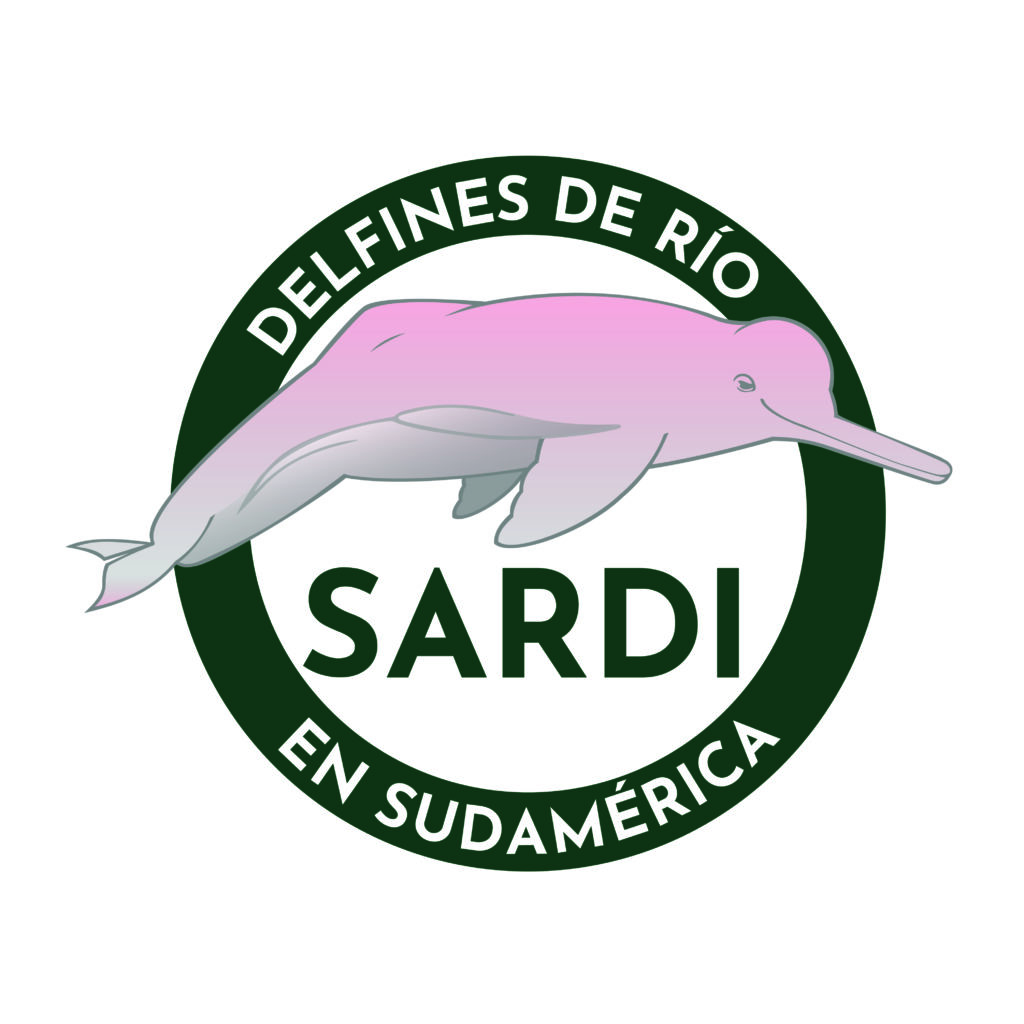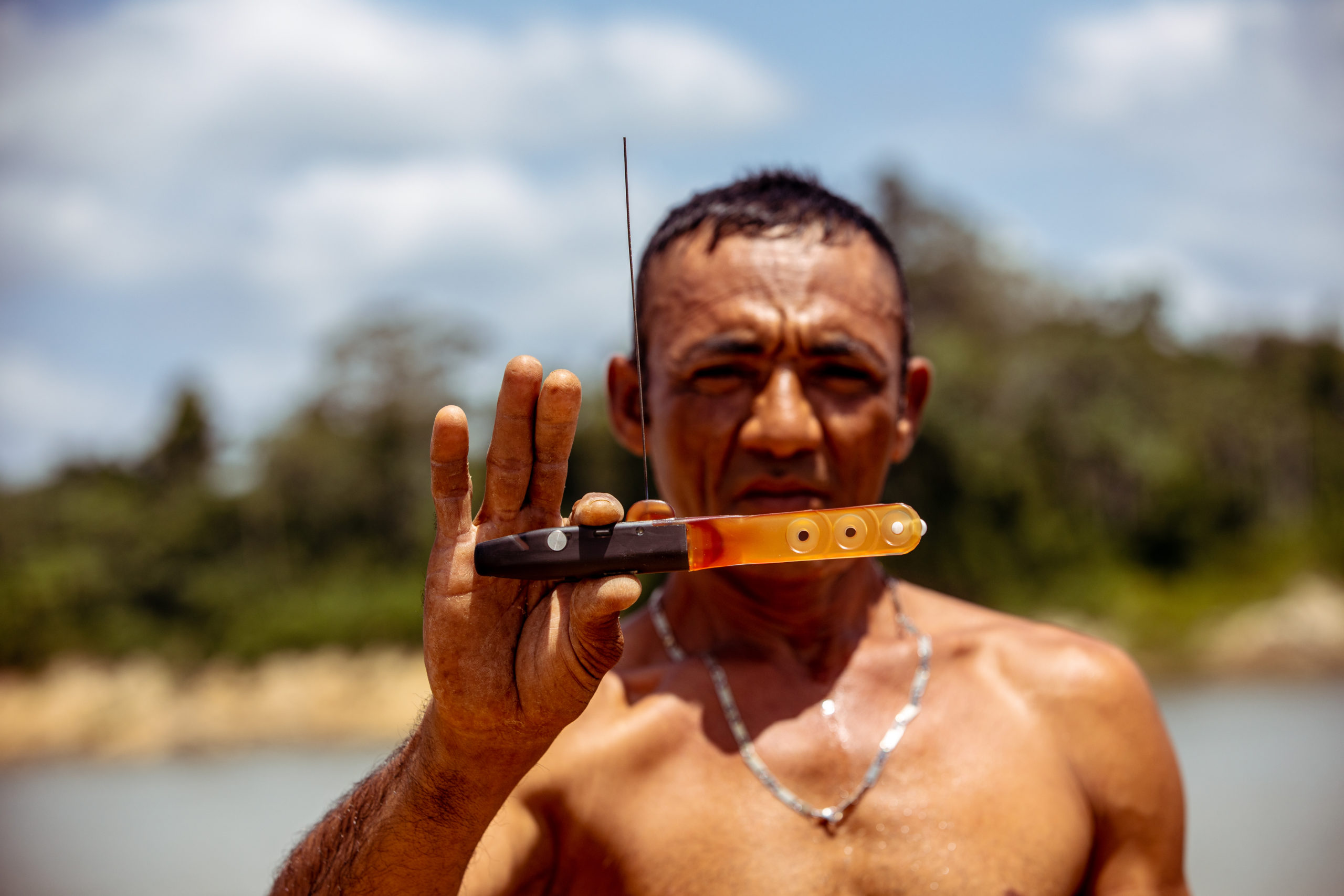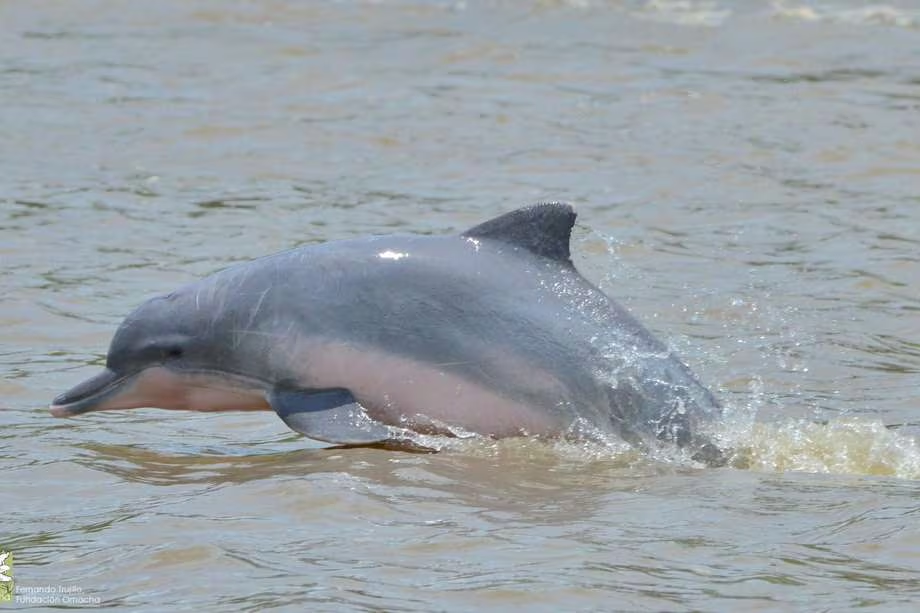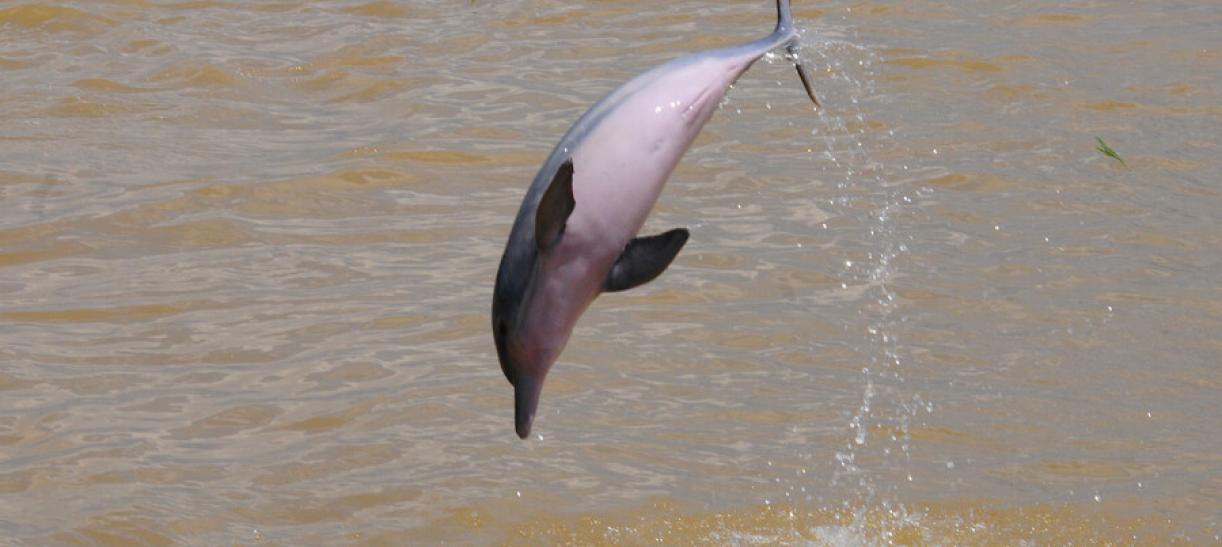In late February, WWF Colombia and Omacha Foundation led a scientific expedition to study the state of conservation of these species in the Guaviare river and install a new satellite transmitter on a pink dolphin. How does this process work and why is it so important?
From space, many eye-like satellites observe the Earth. During the last four years, one of these 2,300 satellites has been carrying out a fascinating task: capturing the signals sent by 34 satellite tags attached to river dolphins in South America. These devices, which at first sight look simply like a large piercing on the animal’s dorsal fin, have a battery that lasts 240 days and are designed to fall off a year to a year and a half, at most, after being installed.
The French satellite Argos, a pioneer in generating telemetric satellite services to study wildlife, oversees these pink dolphins. Each transmitter has a specific frequency and is managed using a special platform, so every time the satellite passes by, it captures a signal, stores it, and sends the registry to the user.
Some days it is possible to obtain up to 20 registries, but there are others with no information at all (when the satellite passes by and there are no dolphins breathing on the surface). In fact, most satellites work better in temperate zones than in equatorial countries like Colombia since they generally orbit over their country of origin and have a weak signal in areas along the equator. The data that the Argos satellite sends is crucial to determine the health of dolphins and, therefore, the health of the rivers they inhabit.

The 2021 Guaviare Expedition
River dolphins are an umbrella species. Since they require large areas to live in their natural state, they serve as a channel to conserve their entire associated ecosystem. Therefore, if the species is doing well, there is guarantee that their environment is also healthy. Monitoring these cetaceans is key because a great number of other species benefit from the efforts aimed at their conservation.
This was the main reason why, on February 28, WWF Colombia and Omacha Foundation installed a new transmitter on a female dolphin in the Guaviare river in the Colombian Amazon. There are now 16 tagged individuals in Colombia in a satellite tagging project for river dolphins that began four years ago as part of the South American River Dolphin Initiative (SARDI).
For 11 days, 30 researchers from different universities and organizations embarked on a 410-km-long journey along the Guaviare river—referred to as the 2021 Guaviare Expedition—to estimate the abundance of river dolphins and compare it with the results of a similar monitoring exercise carried out in 2016 in this same meeting place between the plains of the Orinoco region and the Amazon jungle. The 2021 Guaviare Expedition also served to carry out the area’s first biologic characterization.
José Saulo Usma, Freshwater Specialist at WWF Colombia and one of the scientists who led the expedition, explains, “We have returned to the Guaviare river to determine whether populations have increased, decreased, or remained stable. This is relevant since the pink dolphin (Inia geoffrensis) was categorized as endangered (EN) in 2018. If their numbers are decreasing, it is important to establish and address the causes to mitigate them and help populations recover. During the expedition, we also answered the call made by CDA and the Governorate of Guanía to generate knowledge about plant and animal diversity in the Guaviare river—a task fulfilled by a prominent group of specialists from various organizations.”
The Capture: from Adrenaline and Fear, to Complete Satisfaction
Tagging a dolphin with a ring-shaped transmitter is a rigorous operation. It requires skill, swiftness, and knowledge. The top priority is the life and wellbeing of the animal, so if something goes wrong, it must return to the water as soon as possible, even without the device.
Local fishermen are key in the process, since they use their ability to detect dolphins in the water to identify them and throw a wide net to enclose the area. Meanwhile, biologists from Omacha Foundation and WWF Colombia jump into the water to hold the net and avoid any loose points through which the animals might escape. The enclosure becomes smaller—though always deep enough to keep the animal safe—until 6 to 8 people can hold the dolphin and take it to the shore.
A special tarpaulin and other necessary instruments are set out on the ground to receive the dolphin. Thereon begins a whirlwind series of quick yet precise actions, for the goal is to carry out the entire operation in fewer than 15 minutes. In this limited timeframe, scientists must wet the dolphin constantly, hold it firmly, caress it to calm it down, and cover its eyes to make sure that it does not get nervous from all the movement in its surroundings. Meanwhile, other teammates determine the dolphin’s sex, measure it, examine its skin, record its breathing rate and cardiac frequency, and take samples for studies on DNA sequencing, presence of mercury, and microbiologic cultures. They also inject anesthesia into the dorsal fin, place the tag, and apply disinfectant and healing products on the area before lifting the animal once again to weigh it and release it into the water.
Fernando Trujillo, Scientific Director of Omacha Foundation and leader of the procedure, explains, “The apprehension is constant until we return the dolphin to the water, especially when it’s in the net. That’s why there are a lot of us around, to make sure that the animal does not get tangled while trying to escape because it needs to reach the surface to breathe. Then comes the rush of doing the job well and quickly to return the dolphin to the water as soon as possible. While installing the tag and taking samples, I feel very excited to feel the dolphin, transmit a feeling of tranquility, and make it understand that we will not harm it, that it will return safely to the water. The moment of happiness, of having achieved our goal, comes when we return the animal to the water. In this case, when we saw the dolphin move away with its calf, we felt complete satisfaction.”
What Has the Tag Shown?
Ten days after installing the satellite tag, scientists have observed that the movements of this female Inia geoffrensis correspond to a segment of the river with beaches and small coves, which are good places to spend time with its calf and find fish, their main source of food. Immediately after the release, the calf and mother swam to a lagoon. According to Fernando Trujillo, “They were surely looking for refuge and a place to be at peace; they went out into the river a few days later and have been moving, but only short distances.”

Though 10 days is a short time, the other dolphins tagged during these years have led to important conclusions:
- In places where fish productivity is high, like the Amazon river, dolphins remain in a single area because they do not have to move long distances to find food. Dolphins move much more in rivers with less productive waters.
- In shallow waters, they remain in the main tributaries of rivers because fish are easy to catch. When the water level rises, they use lagoons and smaller tributaries to find their food.
- “Governments cannot establish policies to conserve an entire river, but if we—as scientists—identify critical areas that are not only important for dolphins, but also for fish, turtles, manatees, otters, and caimans, to mention only a few, we can talk about aquatic biodiversity hotspots that need protection,” explains Trujullo.
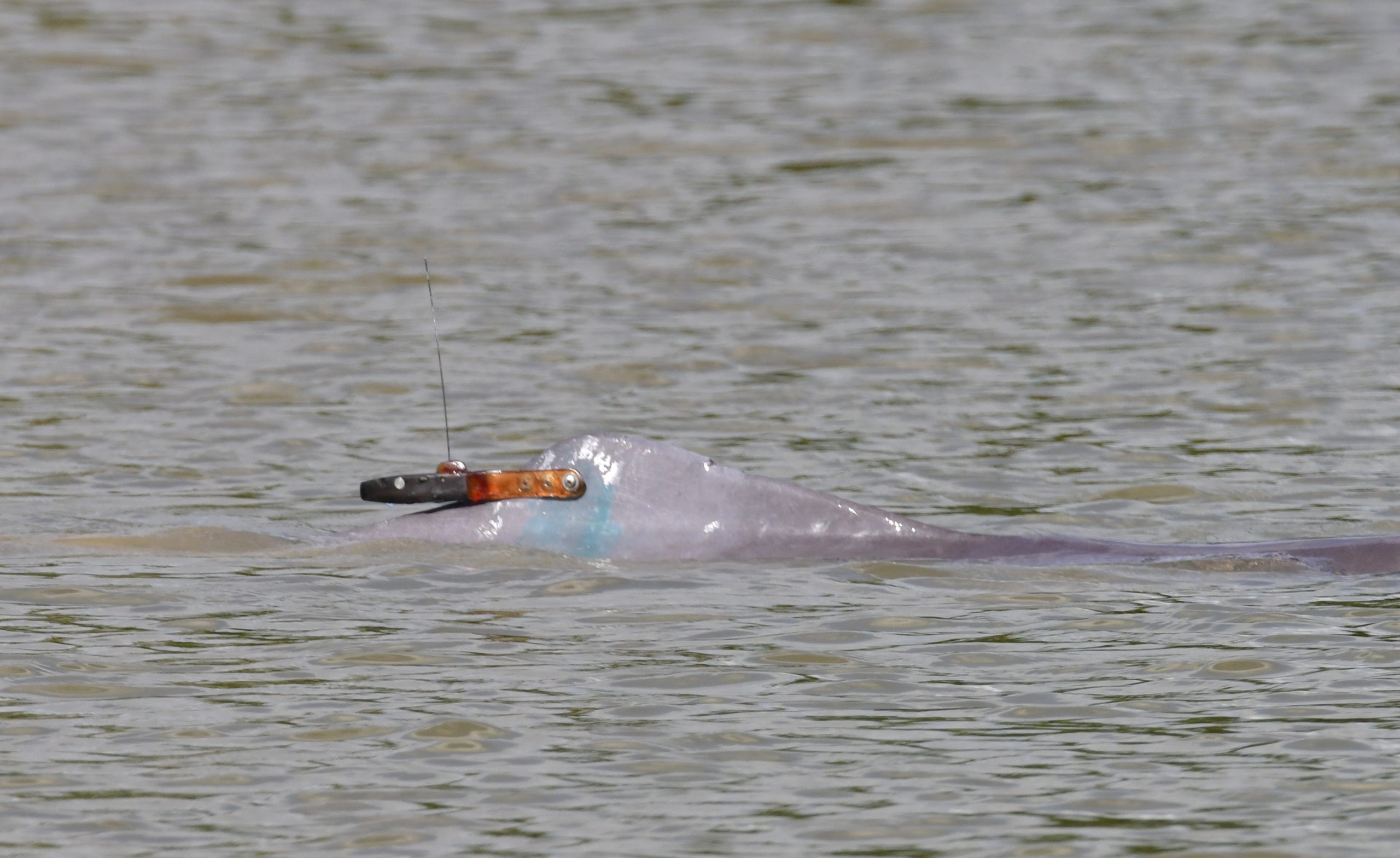
How Much Did the Estimate of the Dolphin Population Change Between 2016 and 2020?
During the 2021 Guaviare Expedition, researchers travelled 410 km on the Guaviare river and observed 188 pink dolphins (Inia geoffrensis). In addition to the total number of dolphins, the team of observers records data like:
- Geographic coordinates to map the presence of dolphins.
- Weather conditions to know how easy or hard it will be to observe individuals, since scientists could over or underestimate the number of animals observed.
- Distance between animals and the boat and riverbank, as well as a registry of animals in groups or alone.
- Biological conditions of the surroundings: type of shores and habitats to assess the way in which dolphins use the habitats they inhabit.
- Presence of human communities and trammel fishing nets, which represent a risk for dolphins that may get tangled up and die (bycatch).
Researchers then calculate the total abundance of dolphins by processing their data using a specialized software that analyzes the number of individuals observed per kilometer of river travelled and the width of cross-sections along the boat’s path, 100 meters away from the shore, regardless of whether it is a cliff, beach, rocks, floating pastures, or firm land. That is how scientists estimate the approximate number of dolphins in a river.
This methodology has been standardized and is used by the countries that form part of SARDI, which allows them to generate data that can later be compared across time and space and arrive at an estimate of regional abundance. The methodology also allows researchers to go on long river voyages to identify their threats, uses, human populations, and economic activities and assess the presence of other species based on studies made by other biologists.
In 2016, Omacha Foundation and WWF Colombia navigated the Guaviare river from San José del Guaviare to Inírida, Guanía (1,080 km). Today, almost a month after returning from the 2021 Guaviare Expedition, the diagnosis is bittersweet.
“As a preliminary result,” explains Fernando Trujillo, “we observe a slight decrease in the number of encounters with dolphins. In general, they had a low level of activity along the center of the river’s channel, without going close to the shore, where fish usually swim. We also noted that the habitat of the riverbank had less biodiversity, since we did not observe primates or turtles; there were few aquatic birds and a single encounter with caimans. There were more people and settlements along the journey and many fishing nets that, until 2016, were banned. Of course, we must analyze this carefully and take note of the results provided by contributing scientists from other fauna and flora research groups. We all want the river to not suffer degradation processes and to remain healthy—for the wellbeing of nature and people.”
